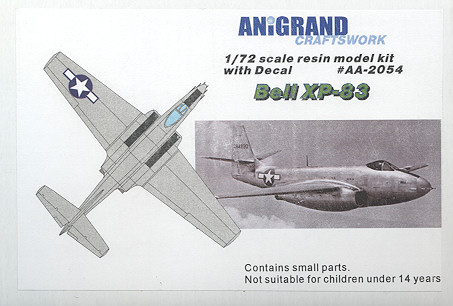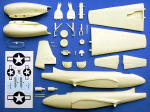
| KIT: | Anigrand Craftworks 1/72 Bell XP-83 |
| KIT #: | AA-2054 |
| PRICE: | $44.00 from Anigrand USA |
| DECALS: | One option |
| REVIEWER: | Scott Van Aken |
| NOTES: | Resin kit with vacuformed canopy |

| HISTORY |
In 1942, Bell designed the first U.S. jet fighter P-59. Due to its small capacity of fuel tank and fuel-hungry engine, it was lacking operational range and only served as a trainer plane. In 1943, the USAAF issued a requirement for a long range fighter with sufficient range to escort bombers over very long distance. Convair's XP-81 and North American's XP-82 were results of this requirement. As the USAAF preferred a pure jet-powered fighter, Bell was also asked to propose a design based on its P-59 experience. In July 1944, Bell submitted Model 40 and two prototypes were ordered, designated XP-83. Only seven months later, the first XP-83 made its first flight in February 1945. However, It was judged under-power and unstable, much to the chagrin of Bell. With the end of the war, the need for a long-range fighter went with it and the XP-83 project was abandoned. The first XP-83 was used in ramjet test until it crashed in September 1946. The second XP-83 was used in gunnery test until it to was no longer useful and was scrapped in 1947.
| THE KIT |
 No surprises in this one. Opening the box shows the same type of kit that Anigrand has been producing since day one. Somewhat deep engraved panels in tan resin with the usual small air pockets on the ends of some parts and in the wheel wells. Remnants of pour stubs and some resin flash is also evident, though I should point out that the image which accompanies this article was yanked from the Anigrand website. They do such a nice job of laying out parts and cleaning them up!
No surprises in this one. Opening the box shows the same type of kit that Anigrand has been producing since day one. Somewhat deep engraved panels in tan resin with the usual small air pockets on the ends of some parts and in the wheel wells. Remnants of pour stubs and some resin flash is also evident, though I should point out that the image which accompanies this article was yanked from the Anigrand website. They do such a nice job of laying out parts and cleaning them up!
Parts come in the usual sectioned off clear bag, but this time, the additional decal bits and the canopy are in their own small zip-lock bag. The rest of the decal sheet is from their P-59 kit. I found these decals to be a tad thicker than what they use today. You may well want to consider some aftermarket insignia, but the kit ones will do fine if you want to use them.
Interior is typically basic with just a seat, instrument panel and control stick. You can probably use the P-59 instrument decal on this as the cockpits were quite similar. The addition of some tape or aftermarket seat belts will add quite a bit to an otherwise Spartan cockpit. No indication of weight is shown, but I'll bet that some will be helpful. There is some room in the nose or behind the cockpit for you to add some. Anigrand provides a length of resin rod to be cut for machine guns. If you have access to small tubing, this would look even better.
Standard Anigrand instructions with history, photo, parts list and exploded view on one side and color/decal placement on the other. In line with the huge majority of 40's and 50's prototypes, it is in unpainted aluminum with Interior Green cockpit and chromate green wheel bays. The nose anti-glare panel and wing walkways will have to be painted black.
| CONCLUSIONS |
This is not a complex kit and the design of it is such that those of us who are used to resin kits will have this one built in good order. Its simplicity is also such that it makes an excellent kit for those new to resin models. It is definitely something a bit different from the norm and once you build one of these, you will be somewhat addicted to them and find yourself wanting to do more!
Thanks to Anigrand USA for the review kit. Get yours direct from the hyperlink to the left, and pay no shipping in the US.
If you would like your product reviewed fairly and quickly by asite that has over 300,000 visitors a month, please contactme or see other details in the